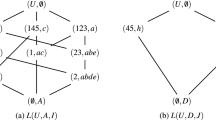Abstract
The theory of concept lattices is an efficient tool for knowledge discovery. One of the key problems of knowledge discovery is knowledge reduction. This paper proposes a method based on a new discernibility matrix for reduction of concept lattices in formal contexts. The judgment theorem of consistent sets is examined and the Boolean function to calculate reducts is given. All the reducts of a formal context can be calculated by this discernibility matrix and Boolean function. It is proved that the approach claimed in this paper is equivalent to the well-accepted one proposed in Zhang et al. (Attribute Reduction in Concept Lattice Based on Discernibility Matrix. Lecture Notes in Computer Science, vol. 3642, pp. 157–165, 2005), and the former’s calculation amount is less than the latter’s. In addition, it shows that the essentiality of reduction is to keep the difference between any concept and its child-concepts.
Similar content being viewed by others
References
Belohlavek, R.: Similarity relations in concept lattices. J. Log. Comput. 10, 823–845 (2000)
Formica, A.: Ontology-based concept similarity in formal concept analysis. Inf. Sci. 176, 2624–2641 (2006)
Ganter, B., Wille, R.: Formal Concept Analysis: Mathematical Foundations. Springer, Berlin (1999)
Ganter, B., Stumme, G., Wille, R.: Formal Concept Analysis: Foundations and Applications. Springer, Berlin (2005)
Godin, R.: Incremental concept formation algorithm based on Galois (concept) lattices. Computat. Intell. 11, 246–267 (1995)
Kent, R.E.: Rough concept analysis: a synthesis of rough sets and formal concept analysis. Fundam. Inform. 27, 169–181 (1996)
Kuznetsov, S.O., Obiedkov, S.A.: Comparing performance of algorithms for generating concept lattices. J. Exp. Theor. Artif. Intell. 14, 189–216 (2002)
Qi, J.J., Wei, L., Li, Z.Z.: A Partitional View of Concept Lattice. Lecture Notes in Computer Science, vol. 3641, pp. 74–83. Springer, Berlin (2005)
Rajapakse, R.K., Denham, M.: Text retrieval with more realistic concept matching and reinforcement learning. Inf. Process. Manag. 42, 1260–1275 (2006)
Saquer, T., Deogun, J.S.: Concept approximations based on rough sets and similarity measures. Int. J. Appl. Math. Comput. Sci. 11, 655–674 (2001)
Sutton, A., Maletic, J.I.: Recovering UML class models from C++: A detailed explanation. Inf. Softw. Technol. 49, 212–229 (2007)
Tho, Q.T., Hui, S.C., Fong, A.C.M., et al.: Automatic fuzzy ontology generation for semantic Web. IEEE Trans. Knowl. Data Eng. 18, 842–856 (2006)
Tonella, P.: Using a concept lattice of decomposition slices for program understanding and impact analysis. IEEE Trans. Softw. Eng. 29, 495–509 (2003)
Wille, R.: Restructuring lattice theory: an approach based on hierarchies of concepts. In: Rival, I. (ed.) Ordered Sets, pp. 445–470. Reidel, Dordrecht (1982)
Zhang, W.X., Wei, L., Qi, J.J.: Attribute Reduction in Concept Lattice Based on Discernibility Matrix. Lecture Notes in Computer Science, vol. 3642, pp. 157–165. Springer, Berlin (2005)
Zhang, W.X., Yao, Y.Y., Leung, Y.: Rough Set and Concept Lattice. Xi’an Jiaotong University Press, Xi’an (2006)
Author information
Authors and Affiliations
Corresponding author
Rights and permissions
About this article
Cite this article
Qi, JJ. Attribute reduction in formal contexts based on a new discernibility matrix. J. Appl. Math. Comput. 30, 305–314 (2009). https://doi.org/10.1007/s12190-008-0174-9
Received:
Revised:
Published:
Issue Date:
DOI: https://doi.org/10.1007/s12190-008-0174-9




